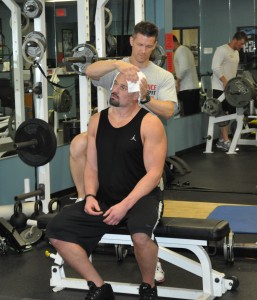There are a lot of opinions and misinformation on the internet regarding neck training, so NeckTraining.com was formed to educate all athletes, coaches, parents, trainers, therapists and exercise enthusiasts about the truth about training your neck. Whether you want to get a stronger neck, bigger neck, decrease neck pain or just learn new neck exercises or workouts for your neck, this site has it all.
If you take a look around the internet or ask coaches and trainers, you’re going to see and hear all sorts of different ideas and opinions on the best neck training strategies. While it’s somewhat limited, there is enough information available about neck training to help us understand what works and what doesn’t.
To begin, you need to understand that neck training can have incredible benefits, but doing it wrong can also cause damage. Even one of the leading proponents of neck training on the internet fractured his vertebra by improper spotting on a manual resistance lateral neck exercise. Other people have caused disk damage and spasms, and who knows what else. There are some really stupid things going on out there, so you need to educate yourself thoroughly before engaging in neck training. Every strength and conditioning coach on the planet thinks he/she knows how to properly strengthen the neck, but you’d be surprised at what we’ve seen.
With concussions in the news every day, it is also important to know that neck training may have a role in preventing long-term brain damaged causes by repetitive sub-concussive blows in many sports. The medical community may never jump on board with this theory because it will be difficult to provide scientific evidence of it’s validity. That is because it will be difficult to conduct studies where human beings are subject to multiple blows to the head in an effort to measure impact forces. It just won’t pass scientific ethics committees. So, we may have rely on mathematical models and logic for a while. That was good enough for a lot of people to stop smoking before it was “proven” to cause cancer, so we believe it is a pro-active stance.
If neck training may help prevent brain damage and there are no negative effects, why not include it as part of your training?
But, concussions are only part of the equation. Injuries to the neck are some of the most devastating and debilitating of all. Pain, discomfort, loss of motion, herniated and bulging disks, arthritis, spasms and even paralysis are all part of the picture. Thousands of surgeries are performed each year, and who knows how many could have been prevented by properly training the neck. If you’ve ever experienced problems with your neck or known someone with neck injuries or pain, you understand how all-encompassing and life-altering it can be.
While many people are interested in neck training for injury prevention or concussion prevention, there are also a lot of people who simply want a bigger or stronger neck. Some people want this for sports performance purposes, others want it for aesthetic reasons and others simply enjoy strengthening their entire body. Whatever your reason for being interested in neck training, NeckTraining.com will provide you with quality information so you can do things the right way.
We’ll talk about neck workouts and neck exercises, but we’ll also present the relevant research as well as reviews of different products associated with neck training. We hope that this site helps you or those you work with. Our number one goal is to deliver quality information so that neck training can be done safely and effectively in any situation and with any equipment. Please let us know what you think of the site and what you’d like to see in the future.
Jim Kielbaso MS, CSCS and Adam Stoyanoff MS, CSCS
If you’re interested in football training, check out football speed.

